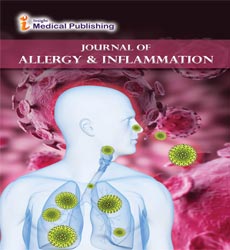Cause of Inflammation to the Nose When the Immune System Overreacts to Allergens in the Air
William Wagner
William Wagner*
Department of Rhinology, Heidelberg University, Mannheim, Germany
- *Corresponding Author:
- William Wagner
Department of Rhinology
Heidelberg University
Mannheim, Germany
E-mail: williamwagner@mhu.de
Received Date: September 06, 2021; Accepted Date: September 20, 2021; Published Date: September 27, 2021
Citation: Wagner W (2021) Cause of Inflammation to the Nose When the Immune System Overreacts to Allergens in the Air. Arch Inflamm Vol.3 No.1:3.
Allergic rhinitis, moreover known as hay fever, could be a sort of irritation within the nose that happens when the immune system overreacts to allergens within the air. Signs and indications incorporate a runny or stuffy nose, wheezing, red, irritated, and watery eyes, and swelling around the eyes. The fluid from the nose is clear [1].
Allergic rhinitis is regularly activated by natural allergens such as pollen, pet hair, and dust. Inherited hereditary qualities and natural exposures contribute to the improvement of allergies. Developing on a farm and having numerous siblings diminishes this hazard. Exposure to creatures early in life might decrease the hazard of developing these particular allergies. Allergic rhinitis is the sort of hypersensitivity that influences the greatest number of individuals.
The characteristic symptoms of allergic rhinitis are rhinorrhea, tingling, sneezing fits, and nasal blockage and obstacle [2]. There can too be behavioral signs; in order to soothe the aggravation or flow of mucus, individuals may wipe or rub their nose with the palm of their hand in an upward movement: an activity known as the nasal salute or the allergic salute. This may result in a crease running over the nose, commonly referred to as the transverse nasal wrinkle, and can lead to permanent physical distortion in case repeated enough. Individuals might too discover that cross-reactivity happens For example, individuals allergic to birch dust may moreover discover that they have an allergic response to the skin of apples or potatoes [3,4].
Pollen is regularly considered as a cause of allergic rhinitis, Inclining variables to allergic rhinitis incorporate skin inflammation and asthma. Allergic rhinitis trigger by the dusts of particular regular plants is commonly known as hay fever, since it is most predominant amid haying season. The causes and pathogenesis of allergic rhinitis are hypothesized to be affected by both hereditary and natural variables, with numerous recent studies focusing on particular loci that can be potential helpful targets for the illness. Hypersensitivity testing may reveal the particular allergens to which an person is sensitive. Skin testing is the foremost common strategy of sensitivity testing. This may incorporate a patch test to decide in case a specific substance is causing the rhinitis, or an intradermal, scratch, or other test. Less commonly, the suspected allergen is broken up and dropped onto the lower eyelid as a means of testing for sensitivities.
Even if an individual has negative skin-prick, intradermal and blood tests for hypersensitivities, they may still have allergic rhinitis, from a local allergy within the nose. Usually called local allergic rhinitis. Specialized testing is essential to analyze local allergic rhinitis [5].
Allergic rhinitis may be regular, lasting, or episodic. Regular allergic rhinitis happens in specific amid pollen seasons. It does not create until after 6 years of age. Perennial allergic rhinitis happens all through the year. This sort of allergic rhinitis is commonly seen in young children. Avoidance frequently centers on maintaining a strategic distance from particular allergens that cause an individual's symptoms, keeping the domestic dry, Particular anti-allergy zippered covers on household things like pads and sleeping cushions have too demonstrated to be viable in avoiding dust mite allergies. To the young children there's higher chance of allergic rhinitis in those who have early exposure to nourishments or formula or heavy exposure to cigarette smoking within the primary year of life. Rhinitis treatment is to prevent or diminish the side effects caused by the irritation of affected tissues. Measures that are viable incorporate avoiding the allergen.
References
- Wheatley LM, Togias A (2015) Allergic rhinitis. N Engl J Med 372: 456- 463.
- Sur DK, Plesa ML (2015) Treatment of Allergic Rhinitis. Am Fam Physician 92: 985–92.
- Czaja-Bulsa G, Bachórska J (1998) Food allergy in children with pollinosis in the Western sea coast region. Polski Merkur Lek 5: 338– 40.
- Yamamoto T, Asakura K, Shirasaki H, Himi T, Ogasawara H, et al. (2005) Relationship between pollen allergy and oral allergy syndrome. Nippon Jibiinkoka Gakkai Kaiho 108: 971-979.
- Rondón C, Fernandez J, Canto G, Blanca M (2010) Local allergic rhinitis: concept, clinical manifestations, and diagnostic approach. J Investig Allergol Clin Immunol 20: 364–71.
Open Access Journals
- Aquaculture & Veterinary Science
- Chemistry & Chemical Sciences
- Clinical Sciences
- Engineering
- General Science
- Genetics & Molecular Biology
- Health Care & Nursing
- Immunology & Microbiology
- Materials Science
- Mathematics & Physics
- Medical Sciences
- Neurology & Psychiatry
- Oncology & Cancer Science
- Pharmaceutical Sciences
